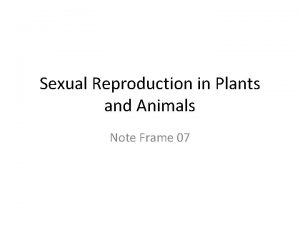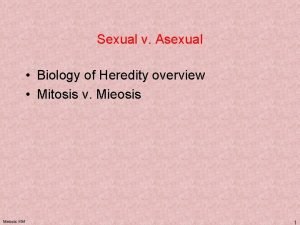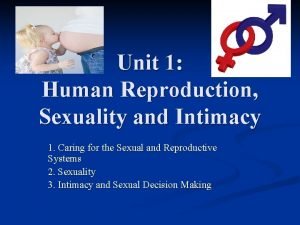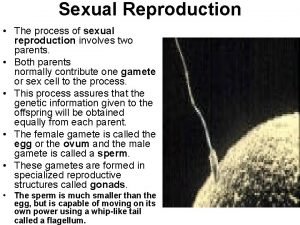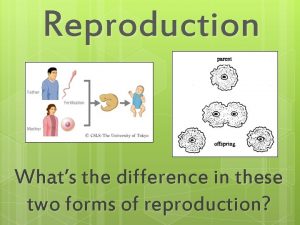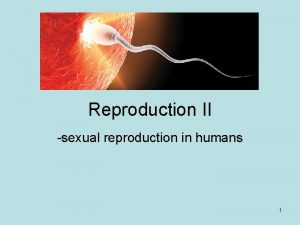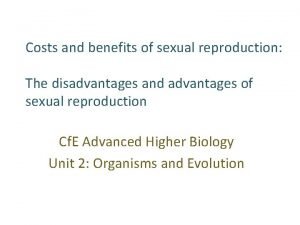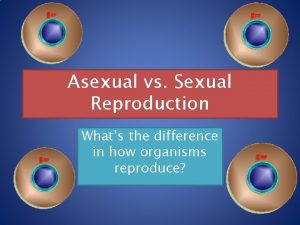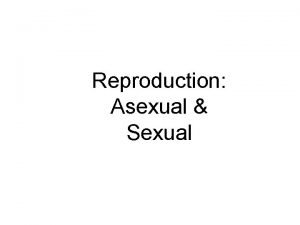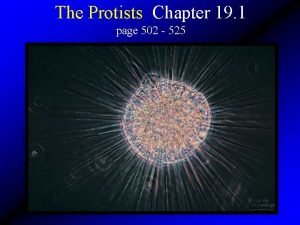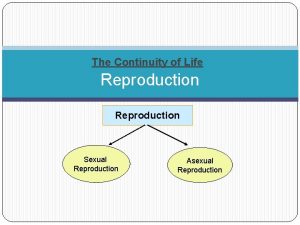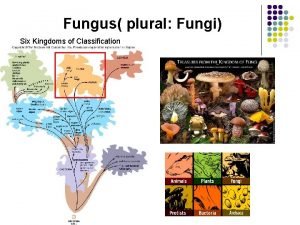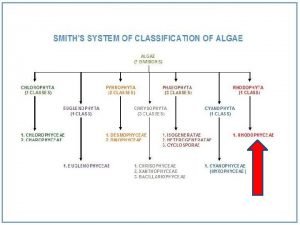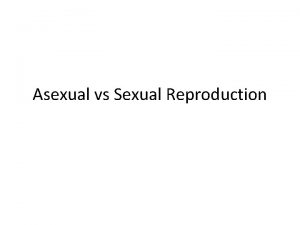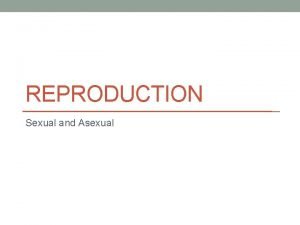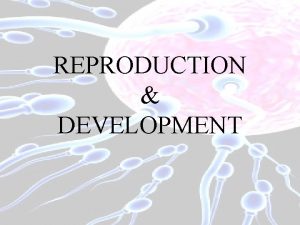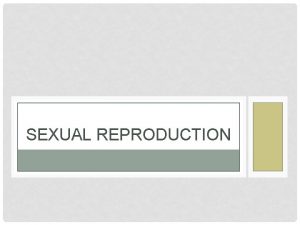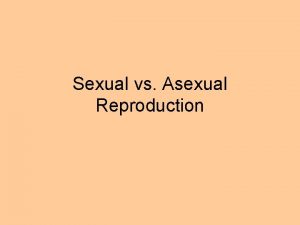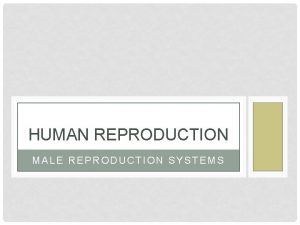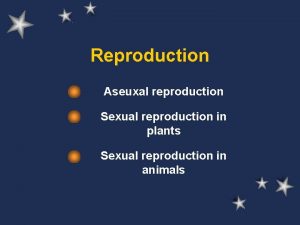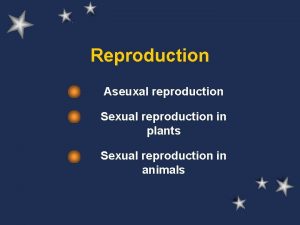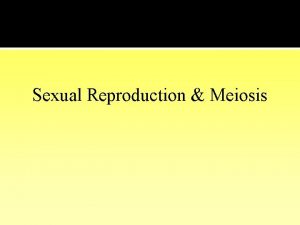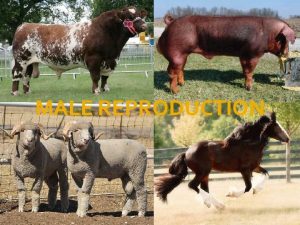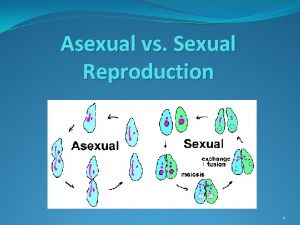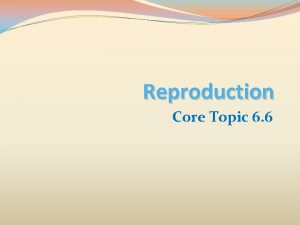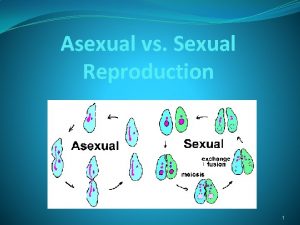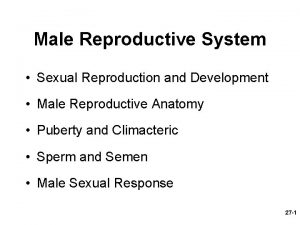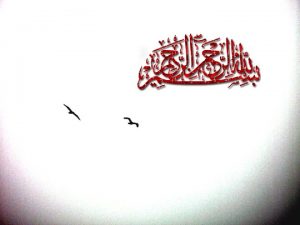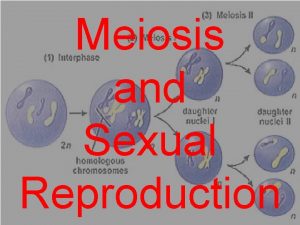Sexual reproduction Requires two parents a male and





































- Slides: 37


Sexual reproduction • Requires two parents, a male and female.

Sexual reproduction • The sex organs make sex cells – Gametes

Sexual reproduction • In male animals the sex cells are called sperm, made in sex organs called testes (testis is singular)

Sexual reproduction • In female animals the sex cells are called eggs, made in sex organs called ovaries.

Sexual reproduction • During sexual reproduction the sperm and egg join together (fertilization) I will die after about 2 days if not fertilized.

The Diversity of Life + Genetics

Fertilization • The joining together of two gametes • Meiosis produces Four HAPLOID daughter cells – Half the genetic material of the parent cell • 1 st diploid cell of the offspring = zygote Sperm (n) + egg (n) = zygote (2 n)

Fertilization Sperm (n) + egg (n) = zygote (2 n) 23 + 23 = 46 • Human gametes have 23 chromosomes

Diversity • As we saw with our Human Traits Survey (a long time ago) there is tremendous diversity in humans • Mendelian Genetics helps explain

Mendelian genetics Gregor Mendel (1822 – 1884) was a monk who was very interested in plant breeding.

Peas Mendel took one pea plant that always produced wrinkled peas and used this plant to pollinate another pea plant that always produced smooth peas

Peas He found that the plants produced (called the F 1 generation) all had smooth peas. F 1 Generation He called this (smooth) the dominant characteristic

Peas When two plants of the first generation (F 1) were cross-pollinated, 75% of the offspring (F 2 plants) had smooth peas and 25% had wrinkled peas. F 1 Generation F 2 Generation He said the wrinkled peas had the recessive characteristic.

Genes We can now explain Mendel’s results using what we know about genes. A gene can be defined as a region of DNA that controls a hereditary characteristic.

Review Chromosomes are X-shaped objects found in the nucleus of most cells. They consist of long strands of a substance called deoxyribonucleic acid, or DNA for short. A section of DNA that has the genetic code for making a particular protein is called a gene.

Genes Our DNA contain two genes (one from our mother and one from our father) for each characteristic (eye color, hair color etc. )

Alleles Different genes for the same characteristic (e. g. eye color) are called alleles. Pron: “Al – eels”

Eye Colors Your eye color depends on which genes you have. Lets look at the genes for brown and blue eyes. The brown eye gene (B) is dominant and the blue eye gene (b)is recessive

Which color eyes? (heterozygous) If you have the alleles for eye color of Bb, you will have brown eyes (because the brown gene is dominant).

(homozygous) Which color eyes? If you have BB, you will also have brown eyes.

(homozygous) Which color eyes? Only if you have bb will your eyes will be blue (both genes are recessive)

Which color eyes? Your combination of genes (BB, Bb or bb) is called your genotype. The color of eyes you actually have is called your phenotype

An example Let’s imagine your mother has Bb genotype and your father also has Bb. Bb Bb

An example Half your mother’s eggs will have B genes and half b (eggs are gametes and only contain one of each pair of genes) eggs B b

An example Half your father’s sperm will have the B gene and half the b gene too. B b Sperm!

Gene diagram (Punnett square) Sperm with B with b We can look at the possible combinations on a gene diagram Egg with B Egg with b

Gene diagram (Punnett square) Sperm with B with b Here all the possible combinations for a fertilized egg Egg with B BB Bb Egg with b Bb bb

Gene diagram This means that there is a 75% chance the baby will have brown eyes (BB or Bb) and only a 25% chance the baby will have blue eyes (bb) Sperm with B with b Egg with B BB BROWN Egg with b Bb BROWN phenotype genotype Bb BROWN bb BLUE

Pure breeding If one parent has both dominant genes(BB), any baby will have to have brown eyes. We say the parent is pure breeding. Sperm with B Egg with B BB BROWN Egg with b Bb BROWN phenotype BB BROWN Bb BROWN

Compare and Contrast Feature # of parents # of offspring Variety of Offspring Speed of Reproduction Timing Asexual Reproduction Sexual Reproduction

Compare and Contrast Feature Asexual Reproduction Sexual Reproduction # of parents One Two # of offspring Variety of Offspring Speed of Reproduction Timing

Compare and Contrast Feature Asexual Reproduction Sexual Reproduction # of parents One Two # of offspring Usually Many Few to Many Variety of Offspring Speed of Reproduction Timing

Compare and Contrast Feature Asexual Reproduction Sexual Reproduction # of parents One Two # of offspring Usually Many Few to Many Variety of Offspring Genetically Identical Genetically Different Speed of Reproduction Timing

Compare and Contrast Feature Asexual Reproduction Sexual Reproduction # of parents One Two # of offspring Usually Many Few to Many Variety of Offspring Genetically Identical Genetically Different Speed of Reproduction Usually Fast Usually Slow Timing

Compare and Contrast Feature Asexual Reproduction Sexual Reproduction # of parents One Two # of offspring Usually Many Few to Many Variety of Offspring Genetically Identical Genetically Different Speed of Reproduction Usually Fast Usually Slow Anytime (once mature) Once mature, only when a mate is available Timing

HW CYU Page 82 #1 -5, 10 -13
 Asexualk
Asexualk The disadvantages of sexual reproduction
The disadvantages of sexual reproduction Sexual and asexual reproduction venn diagram
Sexual and asexual reproduction venn diagram Sexual reproduction
Sexual reproduction Section 1 meiosis
Section 1 meiosis Pedigree miscarriage symbol
Pedigree miscarriage symbol Sexual reproduction and genetics section 1 meiosis
Sexual reproduction and genetics section 1 meiosis Mitosis vs meiosis
Mitosis vs meiosis Chromosome number of animals
Chromosome number of animals Sexual and asexual reproduction in animals venn diagram
Sexual and asexual reproduction in animals venn diagram Chapter 10 sexual reproduction and genetics
Chapter 10 sexual reproduction and genetics Is mitosis asexual
Is mitosis asexual Example of sexual reproduction
Example of sexual reproduction Where does cactus store water
Where does cactus store water Parthenogenesis in mammals
Parthenogenesis in mammals Site:slidetodoc.com
Site:slidetodoc.com Vegetative reproduction requires mieosis.
Vegetative reproduction requires mieosis. Reproduction in humans
Reproduction in humans Chapter 20 sexual reproduction in animals
Chapter 20 sexual reproduction in animals What is sexual reproduction
What is sexual reproduction Define sexual reproduction
Define sexual reproduction Whats reproduction
Whats reproduction A sexual reproduction in humans
A sexual reproduction in humans Parthenogenesis asexual reproduction
Parthenogenesis asexual reproduction Connecting the concepts sexual reproduction
Connecting the concepts sexual reproduction Campbell biology concept check answers
Campbell biology concept check answers Whats asexual reproduction
Whats asexual reproduction Disadvantages of sexual reproduction
Disadvantages of sexual reproduction Significance of sexual reproduction
Significance of sexual reproduction Asexual or sexual reproduction
Asexual or sexual reproduction Chapter 19 protists study guide answers
Chapter 19 protists study guide answers Sexual or asexual reproduction
Sexual or asexual reproduction Plural of fungi
Plural of fungi Sexual reproduction in red algae
Sexual reproduction in red algae Sexual or asexual reproduction
Sexual or asexual reproduction Asexual or sexual reproduction
Asexual or sexual reproduction Asexual or sexual reproduction
Asexual or sexual reproduction Sexual reproduction
Sexual reproduction













